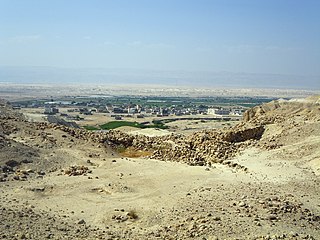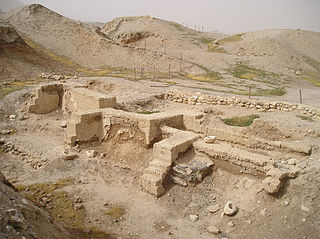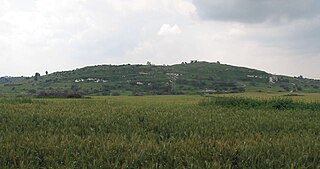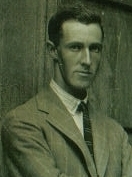
Afula is a city in the Northern District of Israel, often known as the "Capital of the Valley" due to its strategic location in the Jezreel Valley. As of 2022, the city had a population of 61,519.

Gezer, or Tel Gezer, in Arabic: تل الجزر – Tell Jezar or Tell el-Jezari is an archaeological site in the foothills of the Judaean Mountains at the border of the Shfela region roughly midway between Jerusalem and Tel Aviv. It is now an Israeli national park. In the Hebrew Bible, Gezer is associated with Joshua and Solomon.
Beth-Nimrah or Beth-nimrah, also called Nimrin and Bethennabris, was an ancient city in Transjordan, which features prominently the history of ancient Israel and Judah. Tell Nimrin has been identified by Nelson Glueck as the last of three sites successively occupied by the ancient city.

Deir Alla is the site of an ancient Near Eastern town in Balqa Governorate, Jordan. The Deir Alla Inscription, datable to ca. 840–760 BCE, was found here.

Bab edh-Dhra is the site of an Early Bronze Age city located near the Dead Sea, on the south bank of Wadi Kerak with dates in the EB IB, EB II, EB III and EB IVA. Bab edh-Dhra was discovered in 1924 on an expedition led by William F. Albright.

Abila was an ancient city east of the Jordan River in the Plains of Moab, later Peraea, near Livias, about twelve km northeast of the north shore of the Dead Sea. The site is identified with modern Khirbet el-Kafrayn, Jordan and identified on the Madaba Map as an unnamed icon. There is a widely supported theory that in the Hebrew Bible, it is referred to as Abel-Shittim, as well as in the shorter forms Shittim and Ha-Shittim.

Tell el-Hesi, or Tell el-Hesy, is a 25-acre archaeological site in Israel. It was the first major site excavated in Palestine, first by Flinders Petrie in 1890 and later by Frederick Jones Bliss in 1891 and 1892, both sponsored by the Palestine Exploration Fund (PEF). Petrie's excavations were one of the first to systematically use stratigraphy and seriation to produce a chronology of the site. Tell el-Hesi is located southwest of the modern Israeli city of Qiryat Gat.

Tel Maresha is the tell of the biblical Iron Age city of Maresha, and of the subsequent, post-586 BCE Idumean city known by its Hellenised name Marisa, Arabised as Marissa (ماريسا). The tell is situated in Israel's Shephelah region, i.e. in the foothills of the Judaean Mountains, about 2 kilometres (1.2 mi) southeast of Beit Gubrin.
Trinity Southwest University (TSU) is an unaccredited evangelical Christian institution of higher education with an office in Albuquerque, New Mexico. Principally a theological school that encompasses both the Bible college and theological seminary concepts of Christian education, it offers distance education programs and degrees in Biblical Studies, Theological Studies, Archaeology & Biblical History, Biblical Counseling, Biblical Representational Research, and University Studies.
Khirbet Kerak or Beth Yerah is a tell located on the southern shore of the Sea of Galilee in modern-day Israel. The tell spans an area of over 50 acres—one of the largest in the Levant—and contains remains dating from the Early Bronze Age and from the Persian period through to the Early Islamic period.

Livias was a city in Transjordan in Classical Antiquity. In the writings of Josephus (English translation), the name is presented as Julias.

Levantine archaeology is the archaeological study of the Levant. It is also known as Syro-Palestinian archaeology or Palestinian archaeology. Besides its importance to the discipline of Biblical archaeology, the Levant is highly important when forming an understanding of the history of the earliest peoples of the Stone Age.

Tell es-Safi was an Arab Palestinian village, located on the southern banks of Wadi 'Ajjur, 35 kilometers (22 mi) northwest of Hebron which had its Arab population expelled during the 1948 Arab–Israeli war on orders of Shimon Avidan, commander of the Givati Brigade.

The Tulul adh-Dhahab is an archaeological site in Jordan. The site features two neighboring tells, separated by the Zarqa River, an affluent of the Jordan River. The two tells are commonly identified with the ancient Israelite cities of Mahanaim and Penuel, mentioned in the Hebrew Bible.

Gerald Lankester Harding CBE was a British archaeologist who was the director of the Department of Antiquities of Jordan from 1936 to 1956. His tenure spanned the period in which the Dead Sea Scrolls were discovered and brought to public awareness. Without his efforts many of the scrolls might have disappeared into private collections never to be seen again.

Tall Jawa is an archaeological and historical site in central Jordan.
The Book of Joshua lists almost 400 ancient Levantine city names which refer to over 300 distinct locations in Israel, the West Bank, Jordan, Lebanon and Syria. Each of those cities, with minor exceptions is placed in one of the 12 regions, according to the tribes of Israel and in most cases additional details like neighbouring towns or geographical landmarks are provided. It has been serving as one of the primary sources for identifying and locating a number of Middle Bronze to Iron Age Levantine cities mentioned in ancient Egyptian and Canaanite documents, most notably in the Amarna correspondence.

Tell er-Rameh or Tall el-Rama is a small mound in Jordan rising in the plain east of the River Jordan, about twelve miles from Jericho. It presently has a Muslim cemetery on the acropolis that prevents it from being excavated. It has been traditionally identified as the location of Livias. The team recently excavating at Tell el-Hammam however, is proposing that Tell er-Rameh was the commercial and residential centre of Livias, while the administrative centre was located at Tall el-Hammam.

Tell el-Kheleifeh is an archaeological site in Jordan at the head of the Gulf of Aqaba immediately northwest of the city of Aqaba. Its older identification with the 10th-century port from the biblical King Solomon narrative does not stand up to newer archaeological assessments, while its identification with biblical Ezion-geber and/or Elath of a later date remains a matter of speculative interpretation.
















